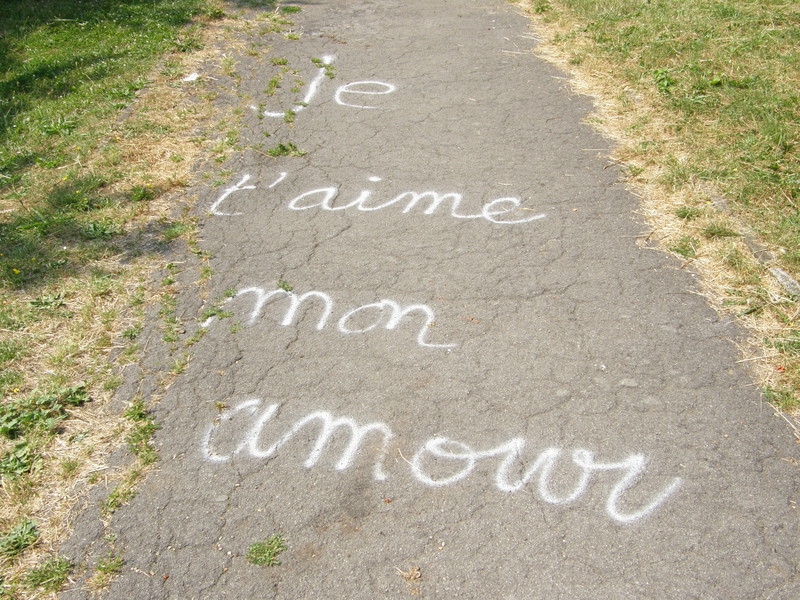
Wow, this is easily the hottest it's been so far this summer. The weathermen are getting all excited about incoming thunderstorms, the station announcers have started warning people to take water with them on the Tube, and summer's cauldron is belching out air as thick as molasses that clogs up your skin, drips down your neck and evaporates in the hot breeze to form dry, sticky patches around your eyes, like a salt flat in miniature.
I hate this kind of weather and find it hard to get out of bed when it's this oppressive; typically, my girlfriend is the opposite, and only starts to perk up once the temperature reaches 30°C. She spends the winter hiding from the world, which is what I tend to do in the summers when I'm not doing stupid things like tubewalking, but this time there's no escaping the heat, as I've got a schedule to keep. Luckily zone 4 isn't as formidable in the baking sun as the centre of town would be, but I still found the going tough today. I'm just not built for this part of the British climate, and it's only going to get worse as climate change sinks its teeth in.
Still, it's nearly August, and then it's September, which is when I will have my revenge, ha, ha...
Leytonstone to Wanstead

Things nearly started out on the wrong foot today. After a long and very hot journey on the Central line from one side of the city to the other, I was looking forward to shaking the numbness out of my buttocks with some light breezes and a bit of respite from the heat, but it wasn't to be. On the way along Church Lane, just before St John the Baptist Church, I passed a bench, where a young Asian man was sitting next to a huge, bald, white man, the pair of them sharing purple cans of super-strength lager and some Monday morning cackles. I didn't catch their eye as I walked past, but that didn't seem to make any difference.
'Oy, you!' the white bloke yelled at me as I reached the bench. '50p!' he said, and put his podgy hand out.
'What?' I said, unable to hide the amazement from my voice.
'Give me 50p,' he said with a snarl. 'Now.'
Normally I'd just smile a sympathetic smile and walk on, but drunks demanding money is a bit much, especially those whose waistlines indicate a decent-enough income, and in this heat, 'a bit much' is effectively a declaration of war. So I stopped walking, stood in front of the bench and looked him in the eye.

'Piss,' I said, slowly extending my middle digit. 'Off,' I continued, concentrating all my overheated frustrations into a look that I hoped summed up the deep irritation I felt at this pasty, gluttonous slacker. Luckily for me, it seemed to shut him up; I don't think he was expecting to see someone quite as frazzled as him this early on a Monday morning, but there I was, hair flailing wildly as I stomped off towards the high street, safe in the knowledge that if this guy had a knife, he'd have a coronary before he managed to catch up... and he'd bloody well deserve one, the idiot.
Thankfully this isn't my first visit to Leytonstone, and I know rude drunks are not remotely representative of the area; indeed, having unloaded my angst, I started smiling at people, and they smiled back. This is a pleasant part of town, out here in east Leytonstone – I was impressed by the suburbs of west Leytonstone on my way to Debden, on the other side of the A12, and the suburbs east of the A-road are just as pretty. Basically, Leytonstone is a lovely place with lots of Victorian and Edwardian architecture, and the terraces along Harvey Road and Leybourne Road are very pleasant to stroll past.
Even more enjoyable is the small but sweet Bush Wood, an area of woodland and long grass that makes a pleasant alternative to the surrounding roads. The only sign of life is the tower of Belgrave Heights poking above the tree-line, and while the busy traffic of Blake Hall Road isn't far away, in the woods it's easy to drift off.
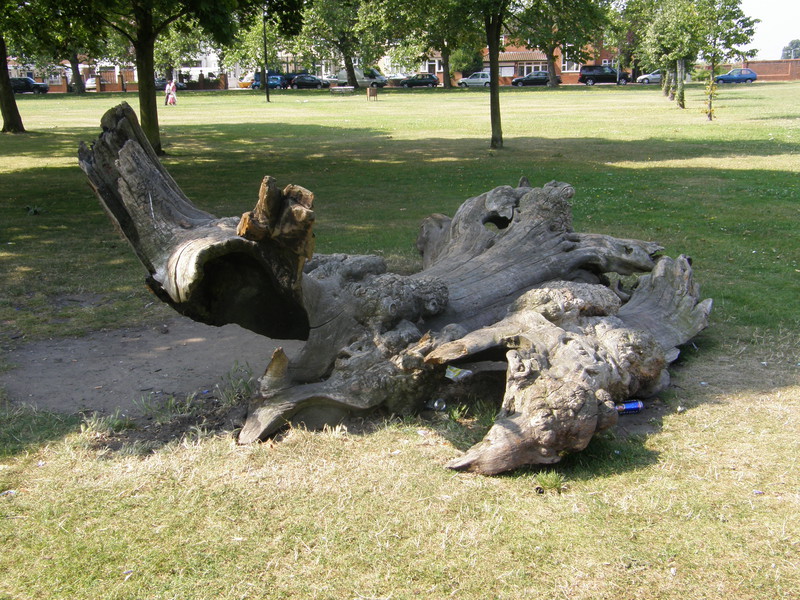
Unfortunately the greenery to the east of Blake Hall Road is off-limits to the public, as it's part of Wanstead Golf Course, so instead you have to skirt around the north of the course, past the pleasant suburban homes along Overton Drive. At the cupola-shaped spire of St Mary the Virgin Church, a left turn into St Mary's Avenue takes you past an entire road of expensive houses that eventually gives way to the grassy expanse of George Green. Keep your eyes out for the husk of an old chestnut tree on the grass to the left, for this tree is famous. Back in the early 1990s this 250-year-old tree was happily minding its own business, but in 1993 the tree became a centre of the ongoing protests against the M11 link road through Leytonstone and Wanstead. The green itself was due to be saved, as the A11 link road would go underground at this point, but as the cut-and-cover method was to be used for this tunnel, it would still have meant the destruction of this ancient tree. Protesters set up camp at the tree and encouraged supporters to send letters to them there, and for a time this enabled the campaign's lawyers to argue that it was a legal residence, thus staying its execution. However on the police evicted everyone from the tree and it was torn down and smashed up; the fragment on the green is left as a memorial to the conflict.
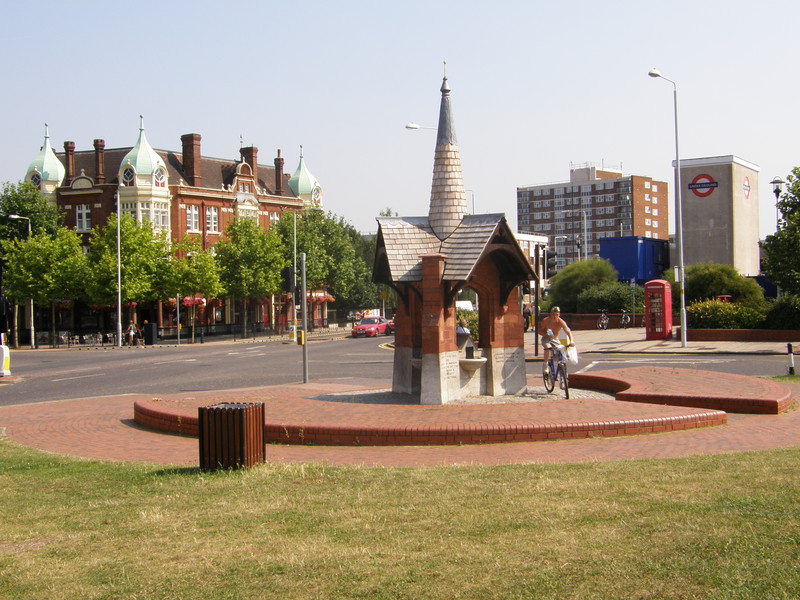
Wanstead station is on the corner of the green, opposite the rather grand pub The George. A fair chunk of the station is currently hidden behind a bunch of blue hoardings, which is a shame because this is another Charles Holden creation, and pictures of the station at its opening in 1947 show clean lines and a lack of clutter that is a bit hard to appreciate with all the... well, clutter around the station at the moment. When the Hainault loop was incorporated into the Central line in 1947, it needed three new stations along the new stretch of tunnel that joined Leytonstone to Newbury Park, and these stations were among Holden's last designs for London Underground; along with Wanstead, he also designed the stations at Redbridge and Gants Hill, which we're coming to next.
Wanstead to Redbridge

Heading south from the station, there's plenty more tidy and enjoyable suburbia, particularly down Warren Road, which runs alongside the greens of the northern part of Wanstead Golf Course. This is a friendly spot, and as if to make up for the shouty drunk back in Leytonstone, I was approached not by one but by two kindly souls who wondered if I was lost (a common side effect of looking at maps in suburban streets). I wasn't, but the second man gave me lots of tips on visiting Wanstead Park, and he was so pleasant I couldn't help smiling at the sky as I turned off the road and down the path he'd pointed out.
Wanstead Park is a gem of a place. The park is Grade II listed and forms part of Epping Forest, and it is a delight to wander through. This was originally the grounds of Wanstead House, but the house is no more, as it was broken up in 1822 and sold to pay off the debts of the Fourth Earl of Mornington, whose wife had inherited the estate. There are some buildings still around, but the joy of wandering through the park is surely down to the lovely lakes that flank the east and south sides of the estate. Currently choked by the blue-green algae that seems to have taken over this part of the world, they're a haven for ducks and swans, and the shady paths that line the lakes are a relief in this evil heat. I only had time to explore the eastern half of the park, but there's plenty more to see in the southern section, and I'll clearly have to come back again one day to finish the job.
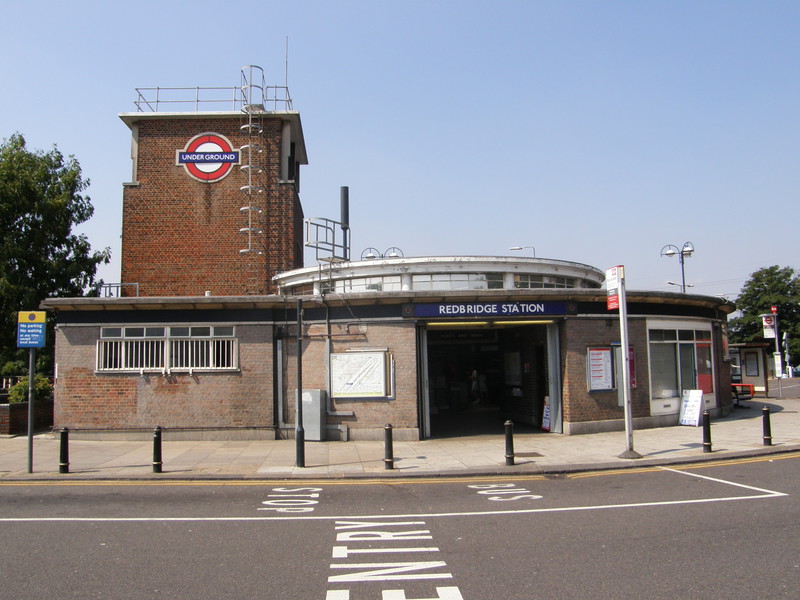
There's a bridge over the North Circular Road in the southeast corner of the park, which is notable because it's one of the few places I've come across with French graffiti. «Je t'aime mon amour Louise» chants the spray-paint along the bridge floor, and the first time you see it, it makes your heart sing; however, it soon repeats itself, and it's not quite as effective. And it repeats itself again. And again. So by the time you reach Wanstead Park Road, you figure that even the most romantic Francophile would agree that once is good, twice is sad, but this many times is a sign of deep insecurity. Run, Louise, run!
The North Circular Road denotes a change in the quality of housing, and on the eastern side the houses start to get a little less interesting as a result. There's a lot more pebbledash and less variety of design, and it makes for a long walk along Wanstead Park Road to the A12, where an underpass takes you to Redbridge station. This is another strong Holden design, with a tall tower sporting the London Underground roundel, and a round ticket hall with upper-level windows that let the light flood in. Things are a little more hectic round here than in Holden's day, as the station is right next to a huge, modern roundabout-and-flyover complex where the North Circular Road meets the A12, but it's still a lovely building.
Redbridge to Gants Hill
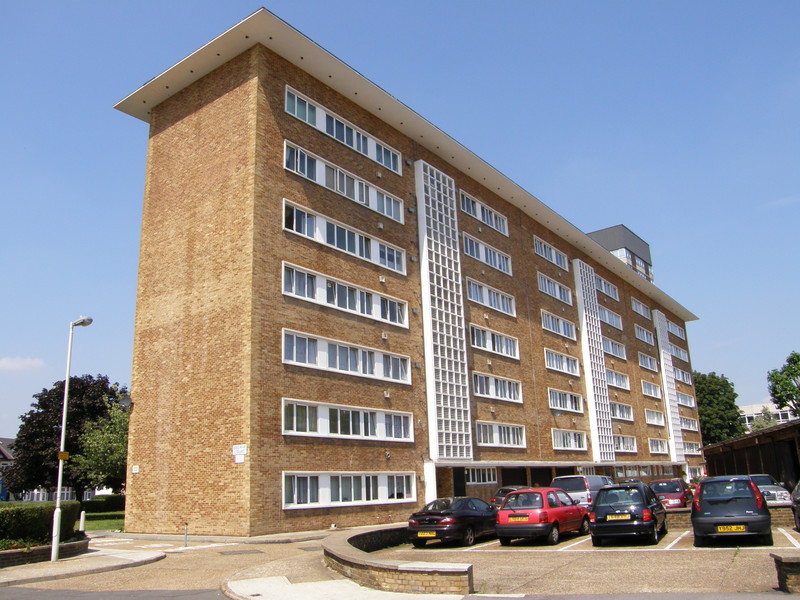
The most direct route from Redbridge to Gants Hill is along the A12, but that's a route for masochists and petrol heads only. Unfortunately the quieter route along the backstreets of Redbridge is not that much more interesting. The houses aren't horrible, but they are rather samey, and Wanstead Lane could be considerably livened up by a few more trees, as there's not a lot of shelter, and in the heat of an English summer, the whole road seems to shimmer in a slightly disquieting manner. You'd think there would be some respite when the road passes the Port of London Authority Recreation Ground, but as this is separated from the road by a fence that means business, it doesn't actually help (and even if the fence wasn't there, the sports ground doesn't contain any trees, so there'd still be nowhere to run). It's a relief to come out the other end and into Gants Hill.

Before reaching the station, keep an eye out for Beehive Court on the left. This was the home of Paul Neil Milne Johnstone, a poet and schoolmate of Douglas Adams, who wrote in The Hitchhiker's Guide to the Galaxy that the worst poetry in the universe was written by Johnstone. The first version of the script referred to Johnstone by name and gave his address as Beehive Court, Redbridge, Essex, but after Johnstone asked that his real address not be used, his name was changed in the book to Paula Nancy Millstone Jennings, and the address to Wasp Villas, Greenbridge, Essex.
Gants Hill station lives under a busy roundabout on the A12, and the only visible signs of the Tube come from the stairwells dotted around the perimeter (though the top of the station is visible in the middle of the roundabout, if you squint hard enough). Beneath ground, though, Gants Hill station is a thing of beauty, particularly down in the station proper; the lower parts of the station were modelled by Holden on the Moscow Underground, and the barrel-vaulted panelled ceiling of the concourse between the eastbound and westbound platforms is well worth checking out.
Gants Hill to Newbury Park

Just south of Gants Hill station is the entrance to Valentines Park, the largest green space in the London Borough of Redbridge. Unfortunately most of the northwest corner is currently cordoned off for redevelopment, which is a shame as this is where you can find Valentines Mansion and the formal gardens, but even with this part closed, there's still plenty of park to enjoy. The Pageant Field just south of the ornamental pond is dotted with lovely trees that are perfect for picnicking under, and to the south of the park is the Cran Brook, which feeds a boating lake and provides the backdrop to a promenade where kids come to scream at the tops of their lungs. It's an enjoyable place, temper tantrums notwithstanding.
Unfortunately the only way to the next station is through yet more suburbia, and it's again fairly bland and slightly worn at the edges. There are no trees to speak of along Quebec Road and Cranley Road, and there are also precious few gardens out front, leaving you with hot, crackling concrete that does as good an impression of the inside of a tandoori oven as I've ever had the pleasure to witness. Finally you reach the omnipresent A12, and there, across the road, is Newbury Park station.

There's been a station at Newbury Park since 1903, when it was part of the Great Eastern Railway branch line from Woodford to Ilford via Hainault. This line was supposed to stimulate suburban growth in the same way as the Metropolitan line, but it never really took off and was eventually merged with the Central line as part of the New Works Programme. The new section of Tube tunnel that was built from Leytonstone via Gants Hill surfaced at Newbury Park, where it was joined to the existing Ilford-Woodford branch. The station itself lives in a cutting alongside the line, and the entrance to the Tube is a modest little doorway that takes you through to a small ticket office, but towering over this doorway is the stunning Newbury Park bus station, and it's this that makes Newbury Park such a great station to behold. Built in 1949 and designed by Oliver Hill, it's a huge barrel-vaulted concrete structure with a green copper-covered roof that manages to look both sturdy and lightweight at the same time. It won an architectural award at the 1951 Festival of Britain, and there's a small plaque to commemorate this on the left-hand side as you walk in; the award was well deserved, I must say.
Newbury Park to Barkingside

When I initially planned this leg, I thought I'd head northwest of the station and cut across the Tube line via a right of way, but both the A-Z and Google Maps are misleading at this point, as you can't actually take the road alongside the Tube line and then turn right over the bridge, whatever they say. After 15 minutes of getting lost and trying not to get killed by the breakneck traffic that spits out of the Sainsbury's access road at speeds that must curdle the milk in the boot, I gave up and headed northeast from the station instead.
The reason for all this shenanigans was the wide open space to the east of the Tube line, which I thought looked well worth a visit. To the north of here was once RAF Fairlop, a minor airfield from the two world wars that was closed in 1946, but that's now the Fairlop Waters Golf Course, and the only area open to ramblers is the bridleway past Aldborough House Farm (which is also private property). It's short, not terribly thrilling and ends abruptly at the golf course, where it turns left and becomes a litter-strewn car park of a road that's presumably used as overspill by all the commuters who use Barkingside.

Happily, Barkingside station is a high note to finish on. It's Grade II listed and deservedly so, sporting a fine cupola on the top of a sturdy red brick ticket hall, with a tiled roof that's staggered in a way that's slightly reminiscent of an oriental pagoda, but in a way that sits well within the suburbs of zone 4. Like the other stations along the original branch line, there's been a station here since 1903, and it was probably designed by WN Ashbee, the designer for the Great Eastern Railway. It hasn't changed much since joining the Underground, and it marks a shift away from the more modern Tube designers like Charles Holden, back to the Edwardian era. It's a theme that continues all the way to the end of the Hainault Loop, but that's for next time...